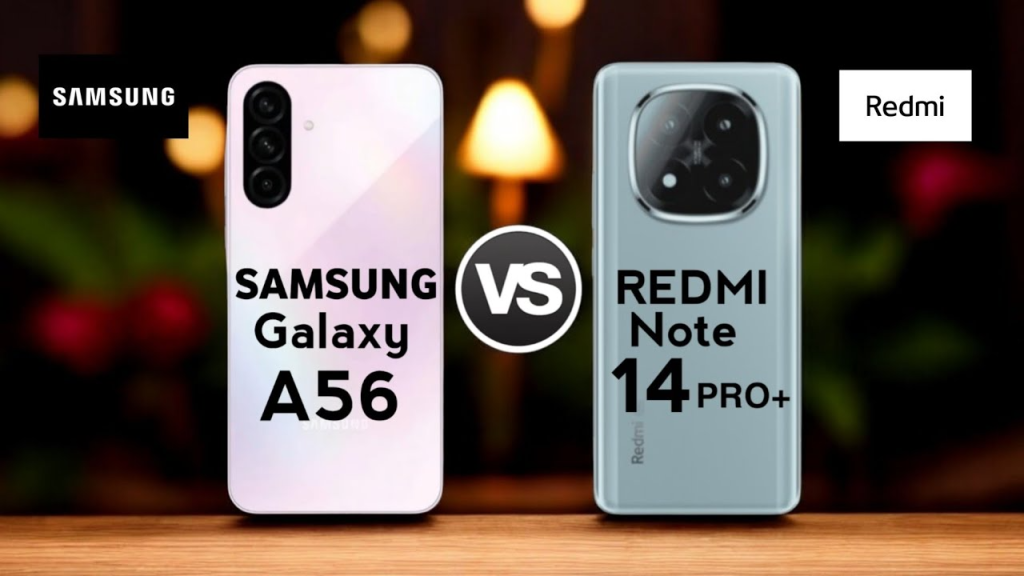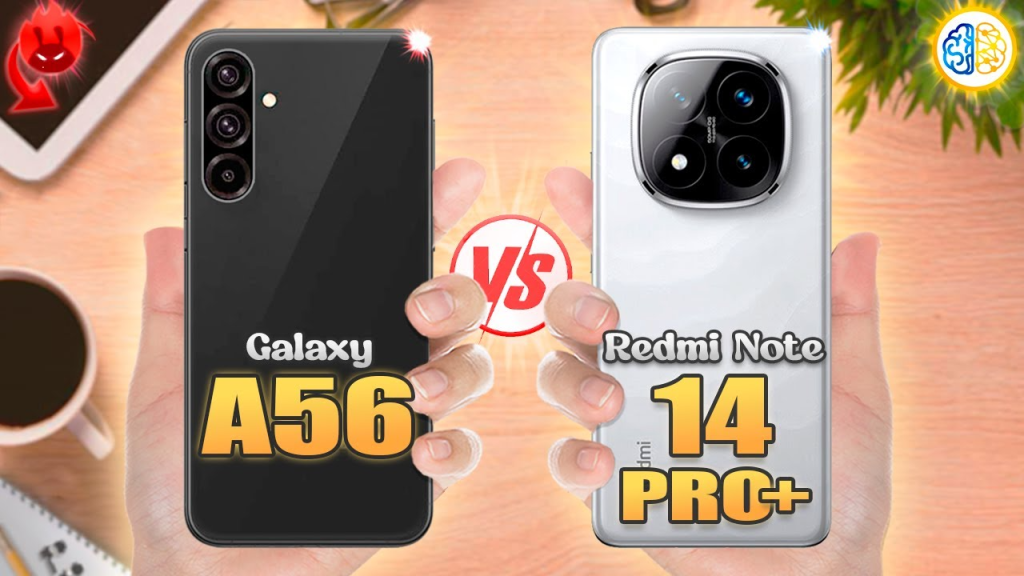
Operating System: The Heartbeat of the Phone
Let’s begin with the heart of any smartphone: the operating system. It’s the platform that runs everything, and it’s something that can make or break your experience with the device. Fortunately, both the Samsung Galaxy A56 and the Redmi Note 14 Pro Plus come with sleek, well-optimized operating systems, but they have different flavors that cater to different tastes.
| Aspect | Samsung Galaxy A56 | Redmi Note 14 Pro Plus |
|---|---|---|
| Android Version | Android 15 | Android 14 |
| Custom Interface | One UI 7.0 | HyperOS |
- Samsung Galaxy A56: One UI 7.0 is Samsung’s latest offering, and it brings a refined experience that’s user-friendly yet highly customizable. If you’ve used a Samsung device before, you’re probably familiar with the clean, intuitive interface. With added features like One Hand Mode, Edge Panels, and Good Lock (if you want to really dig into personalization), it makes day-to-day use smooth and efficient. Plus, the integration with Samsung’s ecosystem (think Galaxy Watch, Samsung Buds, etc.) is top-notch.
- Redmi Note 14 Pro Plus: On the other hand, HyperOS offers a different, yet equally enjoyable experience. It’s fast, responsive, and offers a lot of customization options for those who love to personalize their phone. Xiaomi has packed a lot of features like the Floating Windows and Game Turbo Mode for an enhanced gaming experience. It’s designed to keep things clean, simple, and efficient, but with a ton of features tucked under the hood for those who want to go deeper.
Both have their merits, but One UI 7.0 may feel more refined and polished, especially if you like consistency across devices, while HyperOS offers a more experimental and flexible experience for those who like to tweak their settings.
Cameras: Let’s Talk About the Photography
We live in a time where your phone’s camera is one of the most important features—after all, it’s not just for calling and texting anymore. With both the Samsung Galaxy A56 and the Redmi Note 14 Pro Plus, you’re getting a powerful camera setup, but the real question is: how much camera do you really need?
| Aspect | Samsung Galaxy A56 | Redmi Note 14 Pro Plus |
|---|---|---|
| Rear Camera | Triple: 50 MP (wide, OIS) 12 MP (ultra wide) 5 MP (macro) | Triple: 200 MP (wide, OIS) 8 MP (ultra wide) 2 MP (macro) |
| Front Camera | 12 MP | 20 MP |
- Samsung Galaxy A56: With its 50 MP main camera, you get sharp and vibrant shots in good lighting. The OIS (Optical Image Stabilization) helps keep things steady, so you can shoot without worrying about blurry photos. The 12 MP ultra-wide lens is great for capturing sweeping landscapes or large groups of people, while the 5 MP macro lens gives you that extra detail when you need to get up close. The 12 MP front camera is perfect for selfies, capturing crisp details and vibrant skin tones.
- Redmi Note 14 Pro Plus: Now, here’s where things get exciting! The 200 MP main camera on the Redmi Note 14 Pro Plus is a beast. That’s a 200 MP camera, my friends! That’s insane. If you love detail in your photos or you want to crop in without losing clarity, this camera will do the trick. With the added 8 MP ultra-wide and 2 MP macro, you’ve got a versatile setup for almost any shooting condition. The 20 MP front camera also gives you stunning selfies—sharper, clearer, and more lifelike than most others in this range. If you’re a photography enthusiast, this is the one to go for.
In short: Redmi Note 14 Pro Plus takes the crown for the camera department with its mind-blowing 200 MP lens, but Samsung Galaxy A56 isn’t far behind and still offers excellent performance for the average user.
Durability: Can You Handle the Pressure?
Both phones are built to last, but what happens if you drop your phone in the pool or leave it in a dusty environment? Waterproofing and dust resistance can be a real game-changer in real-world situations. So, let’s see how both devices stack up.
| Aspect | Samsung Galaxy A56 | Redmi Note 14 Pro Plus |
|---|---|---|
| IP Certification | IP67 (dust and water) | IP68/IP69 (dust, water, high pressure) |
- Samsung Galaxy A56: The IP67 rating means it can handle dust and water, making it resistant to submersion in up to 1 meter of water for up to 30 minutes. So if you accidentally drop your phone in the pool or spill a little water on it, no biggie—it can handle it.
- Redmi Note 14 Pro Plus: If you’re someone who’s always on the go, loves the outdoors, or just has that “drop it in the sink” kind of vibe, then IP68/IP69 rating means this phone is built to take more pressure. It’s not just dust and water resistant, but it’s also designed to withstand high-pressure water jets. You can drop it in deeper water, and it will still work like a charm.
So, if you need extra peace of mind when it comes to the elements, Redmi Note 14 Pro Plus offers a more rugged, durable design.
Display: Immersion at Its Best
The display is what connects you to your content. Whether you’re watching videos, gaming, or browsing through social media, having a good screen is essential. Both the Samsung Galaxy A56 and the Redmi Note 14 Pro Plus come with AMOLED displays, which are fantastic for rich colors and deep blacks, but there are subtle differences between them.
| Aspect | Samsung Galaxy A56 | Redmi Note 14 Pro Plus |
|---|---|---|
| Display Type | Super AMOLED | CrystalRes AMOLED |
| Size | 6.7 inches | 6.67 inches |
| Resolution | 1080 x 2340 px | 1220 x 2712 px |
| Refresh Rate | 120 Hz | 120 Hz |
| Protection | Gorilla Glass Victus+ | Gorilla Glass Victus 2 |

- Samsung Galaxy A56: This phone sports a Super AMOLED display at 6.7 inches with a resolution of 1080 x 2340 px, which is sharp and vibrant enough for most users. The 120 Hz refresh rate makes scrolling feel smooth, and Gorilla Glass Victus+ protects it from drops and scratches.
- Redmi Note 14 Pro Plus: The CrystalRes AMOLED display on the Redmi Note 14 Pro Plus offers a slightly higher resolution of 1220 x 2712 px, which means even sharper images and text. The 120 Hz refresh rate is perfect for fluid gaming or smooth scrolling, and the added protection from Gorilla Glass Victus 2 makes it more resistant to drops and scratches.
If you want a display that’s slightly sharper and tougher, then the Redmi Note 14 Pro Plus has the edge.
Battery Life: Power to Get You Through the Day
Let’s face it: we all want a phone that can last all day without needing a charge every few hours. When it comes to battery life, both the Samsung Galaxy A56 and the Redmi Note 14 Pro Plus have solid battery capacity, but their charging speeds are what set them apart.
| Aspect | Samsung Galaxy A56 | Redmi Note 14 Pro Plus |
|---|---|---|
| Battery Capacity | 5000 mAh | 5110 mAh |
| Fast Charging | 45W | 120W |
- Samsung Galaxy A56: The 5000 mAh battery is standard for modern smartphones and should easily get you through a full day. With 45W fast charging, you won’t have to wait long to top up your device when needed.
- Redmi Note 14 Pro Plus: The 5110 mAh battery in the Redmi Note 14 Pro Plus is a tad bigger, but where it really shines is in charging speed. With 120W fast charging, you can charge your phone from 0% to 100% in about 25 minutes. That’s incredibly fast and perfect for those busy days when you need to juice up in a hurry.
Conclusion: Which One Wins?
So, which phone should you go for? Honestly, it depends on what you prioritize. If you’re all about having the best camera, superior durability, and mind-blowing charging speed, then the Redmi Note 14 Pro Plus is probably your best bet. But, if you’re looking for a phone with a refined user experience, a solid camera, and decent performance, the Samsung Galaxy A56 holds its own.
